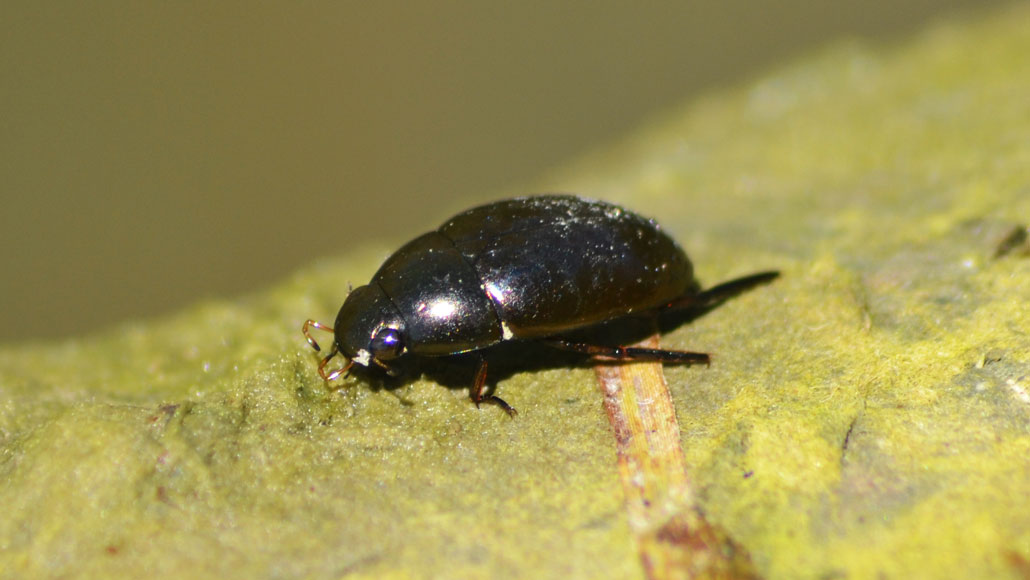Some beetles walk along the underside of the water’s surface
Their upside-down scurrying is a rare way to get around

Water scavenger beetles (one pictured) can reportedly walk along the underside of the water’s surface, a rare ability in the animal kingdom.
Andrew C/Wikimedia Commons (CC BY 2.0)
By Jake Buehler
Being quite small, insects can deal with the air-water boundary far differently than larger animals do. Surface tension allows water striders, for instance, to skate along the top of still waters. But new research reveals something even stranger: Some insects trek along this boundary from the underside.
A water-dwelling beetle can scuttle upside-down along the underside of the water’s surface. It’s as if the water were a solid pane of glass, researchers report June 28 in Ethology. Their report is the first detailed report of a beetle moving this way (which only a few other species can do).
John Gould is a behavioral biologist. He works at the University of Newcastle in Callaghan, Australia. He never set out to look for beetles in the country’s Watagan Mountains. He was just searching, one night, for tadpoles in natural pools of water. In one pool he spotted a black object smaller than a pinky nail.
“At first, I just assumed it must have been a bug that had fallen into the water and was swimming across the surface,” Gould recalls. Then, he realized, “the bug was upside-down — and below the water’s surface.”
Gould quickly filmed the scene. As he did, the beetle — later identified as a water scavenger beetle — walked along the underside of the water’s surface. It did so just as it would on a flat, solid surface. Now and then it rested. Sometimes it changed direction.
Later, Gould mentioned this encounter to Jose Valdez. A wildlife ecologist, Valdez works at the German Centre for Integrative Biodiversity Research in Leipzig. He thought Gould’s observations were interesting. But he was not astonished by them. After all, Valdez had seen insects walk upright along the bottom of a body of water.
In fact, Valdez recalls, “I didn’t fully grasp what [Gould] was describing until he showed me the video.” Only then did he see the beetle was walking upside down along the underside of the water surface. At that point, he says, “I was floored!”
A seldom-mentioned feat
Searching scientific reports, the two found that some snails could move along the underside of the water’s surface. They did this by sliding on a layer of mucus. But there were only a few passing mentions of beetles doing this. And they came from papers written decades ago.
It’s a publication gap that surprised Martin Fikáček. He’s an entomologist at National Sun Yat-sen University in Kaohsiung, Taiwan. The beetles’ ability to walk along the bottom of the water’s surface is known to aquatic beetle specialists. In fact, he notes, they take advantage of it when collecting the beetles. Researchers will unsettle the pond bottom. The beetles respond by floating to the surface. There they skitter around upside-down, he notes. However no one had looked closely at the phenomenon, he admits.
“It’s actually cool that somebody started to think about [how the beetles do this],” says Fikáček. “We always see it. And we never even thought about it.”
Gould and Valdez think these beetles might use their water-walking superpower to stay far away from ambush predators that might lurk along the bottom of these pools. How the insect manages this feat remains unknown. But these scientists have an idea.
Hunting for an explanation
Gould’s video showed an air bubble trapped along the creature’s upturned belly. He and Valdez now think the bubble’s buoyancy may be flipping and pinning the beetle to the underside of the water’s surface. That might allow the insect to put pressure on the water-air boundary with every step. That might also explain tiny hills of water that Gould observed sprouting from the beetle’s feet.
The beetle might indeed be pushing off against the water as the researchers describe, says, Tom Weihmann. He’s a movement physiologist at the University of Cologne in Germany. But that would mean the beetle’s feet are attracted to water. That would contrast with its water-repellant body. “It would have been really interesting,” he now says, “to know which parts of the animals are [water-repellant] and which are not.” He’d also like to know about the anatomy of their feet.
Future research might reveal if the beetles can switch to the opposite side of the water-air boundary, leaving the water entirely. Additional studies on the physics of the beetle’s upside-down water-walking skill could also inspire advances in robotics. Some robots already take moves from water striders.
Says Gould, these findings highlight how often we ignore or miss amazing things that small critters do every day. “Describing the natural history of the small is just as important as describing the natural history of any large mammal or bird.”







